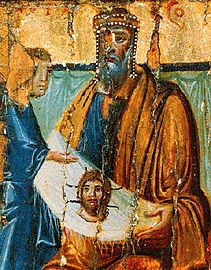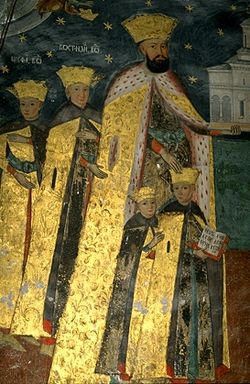August 16 (Eastern Orthodox liturgics)
From Wikipedia, the free encyclopedia
August 15 - Eastern Orthodox liturgical calendar - August 17

All fixed commemorations below are observed on August 29 by Orthodox Churches on the Old Calendar.[note 1]
For August 16, Orthodox Churches on the Old Calendar commemorate the Saints listed on August 3.
Feasts
- Afterfeast of the Dormition.[1][note 2]
- ''Translation of the "Image not made by hands" (Acheiropoieta) of Jesus Christ from Edessa to Constantinople (944)[1][3][4][5][note 3]
Saints
- Martyr Diomedes the Physician, of Tarsus in Cilicia (298)[1][6][7][note 4][note 5]
- Martyr Alcibiades, by fire.[4][9][note 6]
- 33 Martyrs of Palestine, by the sword.[1][8][10]
- Venerable Chaeremon of Egypt (4th century)[1][11][12]
- Saint Anthony the Stylite, of Martqopi, Georgia (6th century)[1][13][14]
- Saint Makarios the Archbishop.[4][15][note 7]
Pre-Schism Western saints
- Saint Ambrose, a centurion put to death under Diocletian, in Ferentino, central Italy (c. 303)[16][note 8]
- Saint Titus, a Deacon martyred during the sack of Rome by the Goths, while distributing alms to the half-starved population (c. 410)[16][note 9]
- Saint Armagillus (Armel), founder of Saint-Armel-des-Boscheaux and Plou-Ermel (Ploermel) in Brittany (c. 550)[16][17][note 10]
- Saint Eleutherius of Auxerre, Bishop of Auxerre from 532–561, who assisted at the Second, Third, Fourth and Fifth Councils of Orléans between 533 and 549 (561)[16][8]
- Saint Simplician, a friend and advisor of St Ambrose, whom he succeeded as Bishop of Milan (400)[16][note 11]
- Saint Stephen of Hungary, King of Hungary (1038)[16][note 12] (see also: August 20 - East)
Post-Schism Orthodox saints
- Saint Joachim, monk, of Osogovo and Sarandapor, Bulgarian monk (1105)[1][18]
- Saint Eustathius II, archbishop of Serbia (1309)[1][18]
- Venerable Nilus of Ereikoussa, nephew of Emperor Theodore Laskaris (c. 1335)[1][19][note 13]
- Saint Romanus the Sinaite, of Djunisa, Serbia (14th century)[1][18]
- Monk-martyr Christopher of Guria, Georgia, at Damascus (15th century)[1][20][21]
- Saint Akakios, Bishop of Liti and Rendini (15th century)[22][note 14]
- Venerable Diodorus, Abbot of Yuriev Monastery, Solovki (1633)[24]
- Venerable New Monk-Martyr Nicodemus of Meteora (1551)[1][4][25][26]
- Venerable Daniel of Meteora.[27]
- Venerable Gerasimus of Kefalonia, the New Ascetic of Cephalonia (1579)[1][4][28][29]
- Saint Raphael of Banat in Serbia (c. 1590)[1][18]
- Venerable Timothy of Euripos (Timothy of Chalcedon), Archbishop, founder of the Pendeli Monastery (1590)[1][4][30]
- New Martyr Stamatius of Demetrias, near Volos, at Constantinople (1680)[1][31][32]
- New Great-martyr Apostolos of the town of St. Laurence, martyred at Constantinople (1686)[1][4][33]
- New Martyrs King Constantin Brâncoveanu of Wallachia,[34] his four sons Constantine,[35] Stephen, Radu, Matthew, and his counsellor Ioannicius[36] (1714)[1][18][note 15] ( see also: May 21)
- Saint Joseph of Văratec Monastery, Romania (1828)[1]
New martyrs and confessors
- New Hieromartyr Stephen, Priest (1918)[18]
- New Hieromartyrs priest Vladimir, and his brother Boris (1931)[18][38]
- New Hieromartyr Alexander Sokolov, Priest, Virgin Martyr Anna Yezhov, and Martyr Jacob Gortinsky (1937)[18]
- Venerable Elder Joseph the Hesychast, of New Skete, Mt. Athos (1959)[39][40][41][note 16][note 17][note 18]
Other commemorations
- Translation of the relics (1798) of Martyrs Seraphim, Dorotheus, Jacob (James), Demetrius, Basil, and Sarantis, of Megara.[1][4][47]
- Repose of Matrona (Popova), in monasticism Maria (1851), disciple of St. Tikhon of Zadonsk.[1]
Icons
- Icon of the Most Holy Theotokos of Saint Theodore ("Feodorovskaya") of Kostroma (1239)[1][48]
- Icon of the Theotokos of Port Arthur (1904)[1]
Icon gallery
- King Abgar with the Image of Edessa
(St Catherine's monastery, Mount Sinai.) - Saint Diomedes, fresco at Hilandar Monastery, Mt. Athos.
- Reliquary of Saint Simplician.
- Portrayal of King Stephen I on the Hungarian coronation pall from 1031.
- King Constantin Brâncoveanu of Wallachia, and his sons (Church mural in Hurezi Monastery).
- Venerable Elder Joseph (Spilaiotis) the Hesychast.
- Theotokos of Saint Theodore ("Feodorovskaya").
Notes
- The notation Old Style or (OS) is sometimes used to indicate a date in the Julian Calendar (which is used by churches on the "Old Calendar").
The notation New Style or (NS), indicates a date in the Revised Julian calendar (which is used by churches on the "New Calendar"). - Third "Feast of the Savior" in August.
- His commemoration is noted in the Jerusalemitic Canonarion (p. 103), without any details about his life. He was likely one of the Archbishops of the throne of Jerusalem.
- Born in the south of Wales, he was a cousin of St Samson. A church in Cornwall was dedicated to him - St Erme. He went to Brittany and founded Saint-Armel-des-Boscheaux and Plou-Ermel (Ploermel).
- On the death of his father, Geza (997), Stephen became King of Hungary. He had married Gisela, a sister of the Emperor Henry II in 995, and they set about enlightening their people. Stephen gradually welded the Magyars into national unity. He organised dioceses and founded monasteries (among them Pannonhalma, which still exists). The declining years of St Stephen were darkened by many misfortunes and difficulties, though he never ceased to be just, kind and merciful. To this day the Magyars consider him their greatest national saint and hero.
- Born Nikolaos Lascaris, son of John Lascaris, the brother of Emperor Theodore I Laskaris), monk, († late 13th / early 14th century), August 16.
- On November 27, 2013 the Sacred Metropolis of Lagada, Liti and Rendini organized the canonization of Saints Akakios and Damaskinos the Studite, who were both Bishops of Liti and Rendini in the 15th and 16th centuries. The feast of Saint Akakios will be celebrated on August 16th and Saint Damaskinos will be celebrated on November 27th. Metropolitan John of Lagada, Liti and Rendini submitted the names of these newly-glorified Saints to be included in the Synaxarion of the Orthodox Church, and with the approval of the Ecumenical Patriarchate this took place in the Sacred Church of Saint Athanasios in Liti. The Ecumenical Patriarchate and the Church of Greece were represented by Metropolitan Anthimos of Thessaloniki during the Hierarchical Divine Liturgy, who was among many hierarchs, priests, monks, government officials and faithful celebrating the first feast of Saint Damaskinos the Studite.[23]
- He ruled Wallachia beginning in 1688. He was a benefactor of many monasteries and churches and cared for the spiritual enlightenment of his people, and the development of printing. He also sought union with Orthodox Russia. In 1714, he was summoned to Constantinople by the sultan, where he was tortured to death for refusing to convert to Islam. His four sons Constantine, Stephan, Radu, Matthew and his counsellor Ianache were also martyred with him.[37]
- On October 20, 2019, at the Protaton Church in Karyes on Mt. Athos, Ecumenical Patriarch Bartholomew announced that the glorification of four great 20th-century Athonite elders would soon proceed, including:
- Daniel of Katounakia (†1929)
- Ieronymos of Simonopetra (†1957)
- Joseph the Hesychast (†1959), and
- Ephraim of Katounakia (†1998)).[42][43]
- "We are especially blessed in America because the founder of monasticism here, Elder Ephraim, made sure that he would bring us the sacred skull of Elder Joseph, who is also his spiritual father."[44]
- In 2019, the Holy Transfiguration Skete of the Holy Trinity-St. Jonas Monastery, in the village of Nescherov in the Kiev Province, established that the monastery would celebrate the elder's memory on the Sunday nearest to the feast of the Dormition, according to the Abbot, His Eminence Archbishop Jonah of Obukhov (ru).[45]
- In December 2019, the foundation of the Katholikon of the new Monastery of Venerable Joseph the Hesychast was laid by Bishop Prodromos of Toliaras and South Madagascar, possibly being the first church to be built in honor of the great 20th-century Athonite father.[46]
References
Sources
Wikiwand - on
Seamless Wikipedia browsing. On steroids.








